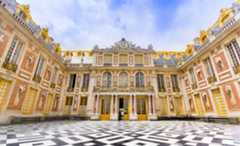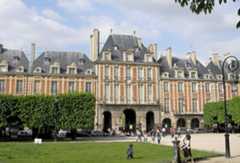Architectural planning
Our editors will review what you’ve submitted and determine whether to revise the article.
- HistoryWorld - History of Architecture
- Art in Context - What is Architecture? � A dive into the world of Architecture in art
- Humanities LibreTexts - Architecture Design, Methods, and Materials
- Open Oregon Educational Resources - Introduction to Architecture - Defining architecture
- Stanford Encyclopedia of Philosophy - Philosophy of Architecture
The architect usually begins to work when the site and the type and cost of abuilding have been determined.
The site involves the varying behaviour of the naturalenvironment that must be adjusted to the unvarying physical needs of human beings; the type is the generalized form established by society that must be adjusted to the special use for which the building is required; the cost implies the economics of land, labour, and materials that must be adjusted to suit a particular sum.
Thus, planning is the process of particularizing and, ultimately, of harmonizing the demands of environment, use, and economy. This process has a cultural as well as a utilitarian value, for in creating a plan for any social activity the architect inevitably influences the way in which that activity is performed.
Planning the environment
The natural environment is at once a hindrance and a help, and the architect seeks both to invite its aid and to repel its attacks. To make buildings habitable and comfortable, the architect must control the effects ofheat, cold,light,air, moisture, and dryness and foresee destructive potentialities such asfire,earthquake,flood, anddisease.
The methods of controlling the environment considered here are only the practical aspects of planning. They are treated by the architect within thecontext of the expressive aspects. The placement and form of buildings in relation to their sites, the distribution of spaces within buildings, and other planning devices discussed below are fundamental elements in theaesthetics of architecture.
Orientation
The arrangement of the axes of buildings and their parts is a device for controlling the effects ofsun,wind, andrainfall. The sun is regular in its course; it favours the southern and neglects the northern exposures of buildings in the Northern Hemisphere, so that it may be captured for heat or evaded for coolness by turning theaxis of a plan toward or away from it. Within buildings, the axis and placement of eachspace determines the amount of sun it receives. Orientation may control air for circulation and reduce the disadvantages of wind, rain, andsnow, since in most climates the prevailing currents can be foreseen. The characteristics of the immediate environment also influence orientation:trees, land formations, and other buildings create shade and reduce or intensify wind, while bodies of water produce moisture and reflect the sun.
Architectural forms
Planning may control the environment by the design of architectural forms that may modify the effects of natural forces. For example, overhanging eaves,moldings, projections,courts, andporches give shade and protection from rain.Roofs are designed to shed snow and to drain or preserve water.Walls control the amount of heat lost to the exterior or retained in the interior by their thickness and by the structural and insulating materials used in making them. Walls, when properly sealed and protected, are the chief defense against wind and moisture.Windows are the principal means of controlling natural light; its amount, distribution, intensity, direction, andquality are conditioned by their number, size, shape, and placement and by the characteristics of translucent materials (e.g., thickness, transparency, texture, colour). But the planning of fenestration is influenced by other factors, such as ventilation and heating. Since most translucent materials conduct heat more readily than the average wall, windows are used sparingly in extreme climates. Finally, since transparent windows are the medium of visual contact between the interior and exterior, their design is conditioned byaesthetic and practical demands.
Colour
Colour has a practical planning function as well as an expressive quality because of the range of its reflection and its absorption ofsolar rays. Since light colours reflect heat and dark colours absorb it, the choice of materials and pigments is an effectivetool of environmental control.
Materials and techniques
The choice of materials is conditioned by their own ability to withstand the environment as well as by properties that make them useful to human beings. One of the architect’s jobs is to find a successful solution to both conditions; to balance the physical and economic advantages of wood against the possibility of fire,termites, andmold, the weather resistance of glass and light metals against their high thermalconductivity, and many similar conflicts. The more violent naturalmanifestations, such as heavy snow loads, earthquakes, high winds, andtornadoes, are controlled by special technical devices in regions where they are prevalent.
Any number of these controls may be out of reach of the planner for various reasons. The urban environment, for example, restricts freedom of orientation and design of architectural forms and creates new control problems of its own: smoke, dirt,noise, andodours.
Interior control
The control of the environment through the design of the plan and the outer shell of a building cannot be complete, since extremes of heat and cold, light, and sounds penetrate into the interior, where they can be further modified by the planning of spaces and by special conditioning devices.
Temperature, light and sound are all subject to control by the size and shape of interior spaces, the way in which the spaces are connected, and the materials employed forfloors, walls,ceilings, andfurnishings. Hot air may be retained or released by the adjustment of ceiling heights and sources ofventilation. Light reflects in relation to the colour and texture of surfaces and may be reduced by dark, rough walls and increased by light, smooth ones. Sounds aretransmitted by some materials and absorbed by others and may be controlled by the form of interiors and by the use of structural or applied materials that by their density, thickness, and texture amplify or restrict sound waves.
Conditioning devices played only a small part in architecture before the introduction of mechanical and electrical systems in the 19th century. Thefireplace was almost the only method of temperature control (though the ancient Romans anticipated the modern water system forradiant heating); fuel lamps and candles had to be movable and were rather in the sphere of furnishings than of architecture; the same is true of thetapestries and hangings used for acoustical purposes and to block drafts.
Today, heating, insulation,air conditioning,lighting, and acoustical methods have become basic parts of the architectural program. These defenses and comforts ofindustrialization control the environment so efficiently that thecontemporary architect is free to use or to discard many of the traditional approaches to site and interior planning.















